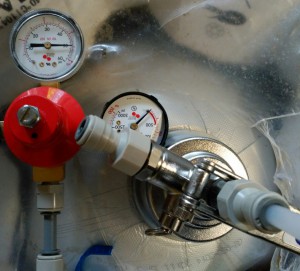Keg… in summer… in the UK… it is a fucking pain in the backside. Currently I am having a “summer of fob”. (“Fobbing” is what happens when a beer is too foamy to serve, “foam on beer”, there are several ways fobbing can occur – carb level, temp, flow rate…)
Keg is quickly becoming core to my distribution business. In fact I’m slowly moving to less and less cask volume and considering dropping cask entirely so I can focus more on keg and packaged beers. But there’s a problem with keg – I’m getting higher ullage rates, and an ullage is effectively eliminated sales volume, work done for nothing – and that hurts my small business. It strains relationships with pubs and breweries too. I’m sat here as the middle-man copping the flack from either side.
There are key problems that I believe the UK beer industry MUST solve:
- Breweries should not be releasing beers that will gain over 1 vol of CO2 outside of the brewery. Let alone 2 or 3 vols! Surely? Is that reasonable? I’ve handled kegs that are up at 6 vol CO2 (in steel thankfully) and had a KeyKeg at 4 vol CO2 recently. That is on the verge of a KeyKeg’s maximum PSI rating at room temperature. If that 6 vol CO2 beer was in KeyKeg it could very well explode at cellar temperature. If breweries do this it’ll only be a matter of time before a serious injury occurs. That could be in the brewery, could be in distribution, could be in the pub…
- Distribution should be keeping kegs cool. This is unpasteurised unfiltered beer folks, it _will_ continue to attenuate somewhat. If you leave your kegs lying around for a week at 20C in summer they’ll probably gain some CO2 and thus result in fobbing. Causing issues at the pub, causing bad vibes, ullaged kegs, and hassles for both distribution and the brewery. I have a 10C coldstore and I’m not happy with that, but many “craft” distributors don’t have a coldstore at all. Hell, too many _breweries_ in the UK don’t. My own goal is to have a 4C-max coldstore for keg and packaged beer products. Some think me a fool… perhaps I am. It certainly isn’t currently a competitive advantage in a market where pubs will do anything to save a fiver.
- Pubs need to learn more about keg beer. The BII ABCQ is pretty much a waste of time, someone interested in their job & beer quality will already know _more_. We need a UK-tailored equivalent to Cicerone. Not just that – but pubs need to _not_ buy 2+ months worth of keg stock at once and then leave it in their 12C cellar. See above point: it _will_ attenuate further, the CO2 will increase, you _will_ have more issues with fobby beer. Ideally I’d love to see pubs with keg cellars below 6C… I’m dreamin’ now… Not every beer will have it in it to go far enough to cause problems, but some will. Just do not buy and store kegs for this long unless you can keep them cold. That’s just plain good practice regardless.
I don’t think a pub ought to have to worry about knowing how to vent kegs to reduce CO2 levels – but whilst the above 3 problems remain unsolved the best alternative I can think of is that pubs need to learn how to do this. Yet the current status in the UK is that most don’t even know how to manage within-acceptable-bounds cases with pressure and flow control. The highest level of UK cellar training is the BII ABCQ and, frankly, it is barely even what I would consider sufficient as a “new-joiner briefing” in a serious bar or pub. It’s crap, it’s designed for Wetherspoons and similar bar chains that have standardised products and support contracts.
I have _NEVER_ come across a keg I cannot get pouring. That 60 PSI steel keg I mentioned worked just fine after some venting, and the beer was actually pretty awesome. KeyKegs are even easier to vent.
Now… how do we fix this? <troll>Pasteurise all the keg beer?</troll>
</braindump>
(I have views on the lack of refrigeration in UK beer retail too… that’s one for another time though.)
